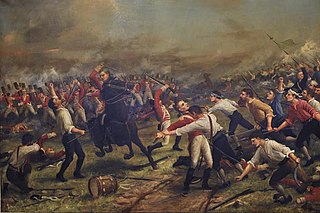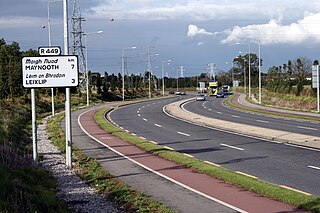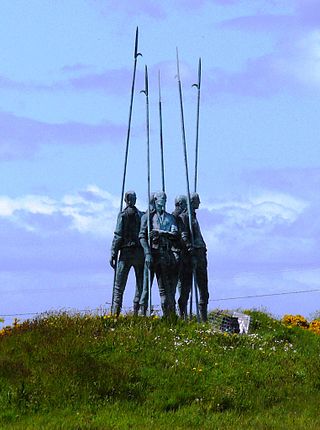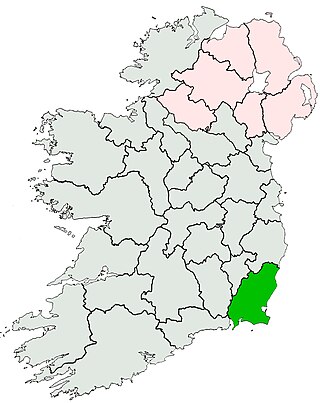
The N11 road is a national primary road in Ireland, running for 129 km (80 mi) along the east side of Ireland from Dublin to Wexford. It passes close to Bray, Greystones, Wicklow, Arklow, Gorey, and Enniscorthy. Beyond Wexford, the route continues to Rosslare as the N25. The road forms part of European route E01. As of July 2019 the N11/M11 is of dual carriageway or motorway standard from Dublin as far as Oilgate in County Wexford.

Enniscorthy is the second-largest town in County Wexford, Ireland. The town is located on the picturesque River Slaney and in close proximity to the Blackstairs Mountains and Ireland's longest beach, Curracloe.

The Battle of Vinegar Hill was a military engagement during the Irish Rebellion of 1798 on 21 June 1798 between a force of approximately 13,000 government troops under the command of Gerard Lake and 16,000 United Irishmen rebels led by Anthony Perry. The battle, a major rebel defeat, took place on 21 June 1798 on a large rebel camp on Vinegar Hill and in the streets of Enniscorthy, County Wexford and marked the last major attempt by the rebels to hold and control territory taken in Wexford.

The Battle of Oulart Hill took place on 27 May 1798 when a rebel gathering of between 4,000 and 5,000 annihilated a detachment of 110 militia sent from Wexford town to stamp out the spreading rebellion in County Wexford.
The Carnew executions refer to the summary execution of 28 prisoners being held as suspected United Irishmen by yeomanry troops from the Carnew garrison stationed in the barracks of Carnew Castle, County Wicklow, Ireland on 25 May 1798.

A regional road in the Republic of Ireland is a class of road not forming a major route, but nevertheless forming a link in the national route network. There are over 11,600 kilometres of regional roads. Regional roads are numbered with three-digit route numbers, prefixed by "R". The equivalent road category in Northern Ireland are B roads.
The Battle of Ballyellis on 30 June 1798 was a clash during the Irish Rebellion of 1798, between a surviving column of the dispersed Wexford rebel army and pursuing British forces which resulted in a victory for the rebels.

The second Battle of Arklow took place during the Irish Rebellion of 1798 on 9 June when a force of United Irishmen from Wexford, estimated at 10,000 strong, launched an assault into County Wicklow, on the British-held town of Arklow, in an attempt to spread the rebellion into Wicklow and to threaten the capital of Dublin.
The Battle of Tubberneering took place during the Wexford Rebellion fought on 4 June 1798 between Crown forces and United Irish insurgents, at Tubberneering south of Gorey in the north of County Wexford. The rebels ambushed and routed the British.
The battle of Ovidstown was a military engagement between British Crown forces and United Irishmen rebels during the Irish Rebellion of 1798 near the town of Kilcock, County Kildare. Despite the initial failures experienced by the United Irishmen in County Kildare during the first months of the rebellion, the consolidation of government forces in the town of Naas and the priority given by the Dublin Castle administration to suppress the Wexford Rebellion in County Wexford meant that much of the county remained in rebel hands since the outbreak of the rebellion. Towns such as Prosperous and Clane were in rebel hands, while towns such as Maynooth, Kilcock and Kildare had been attacked and briefly occupied by the rebels. By 19 June, however, neighbouring County Meath had been judged sufficiently pacified to allow for government forces to be dispatched from that county into Kildare to recapture rebel-held territory.

Joseph Holt was a United Irish general and leader of a large guerrilla force which fought against British troops in County Wicklow from June–October 1798. He was exiled in 1799 to the colony of New South Wales where he worked as a farm manager for NSW Corp Paymaster Captain William Cox and later returned to Ireland in 1814.

John Murphy was an Irish Roman Catholic priest of the Roman Catholic Diocese of Ferns, who is mainly remembered for his central role in the Irish Rebellion of 1798 in County Wexford, which is sometimes known as the Wexford Rebellion. He led the rebels to one of their initial victories over a government militia at Oulart Hill, and in the following weeks became one of the rebellion's main leaders.
Events from the year 1798 in Ireland.

Carnew is a village in County Wicklow, Ireland. It is the most southerly town in Wicklow situated just a mile from the border with County Wexford. For historical reasons it has often been described as "a Protestant enclave".
Father Mogue Kearns, sometimes called Moses Kearns, was an Irish Roman Catholic priest and United Irishman executed by the British on 12 July 1798, after leading 2,000 rebel troops in Wexford.

The Wexford Rebellion refers to the events of the Irish Rebellion of 1798 in County Wexford. From 27 May until 21 June 1798, Society of United Irishmen rebels revolted against British rule in the county, engaging in multiple confrontations with Crown forces. The most successful and destructive rising in all the counties of Ireland, United Irishmen rebels experienced a number of early successes in the county despite being seen as a relatively loyal county by the Dublin Castle administration due to a series of military victories. However, the tide soon turned against the United Irishmen in Wexford as Crown forces poured into the region, engaging in a brutal counterinsurgency which indiscriminately targeted suspected rebels and eventually suppressed all rebel activities in the county.

County Wexford is a county located in the south-east of Ireland, in the province of Leinster. It takes its name from the principal town, Wexford, named 'Waesfjord' by the Vikings – meaning 'inlet (fjord) of the mud-flats' in the Old Norse language. In pre-Norman times it was part of the Kingdom of Uí Cheinnselaig, with its capital at Ferns.

The Battle of Enniscorthy was a land battle fought during the Irish Rebellion of 1798, on 28 May 1798, when an overwhelming force of rebels assailed the town of Enniscorthy, County Wexford, which was defended only by a 300-strong garrison supported by loyalist civilians. On the previous day at nearby Oulart, several thousand rebels led by Fr John Murphy had massacred a detachment of the North Cork militia, amounting to 110 officers and men.
The Battle of Kilthomas took place on 27 May 1798 when combined Loyalist Forces defeated a gathering of several thousand rebels in the greater Ferns/Carnew area, in one of the primary actions of the rebellion in County Wexford. This occurred at the same time as the Battle of Oulart Hill in the east of the county.












